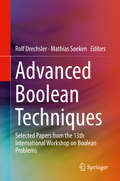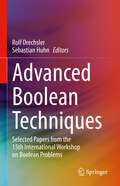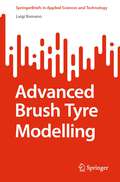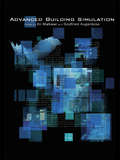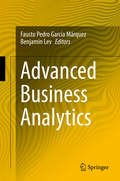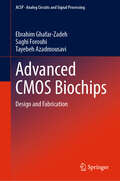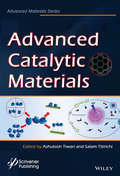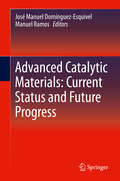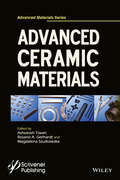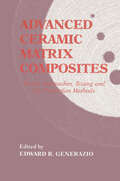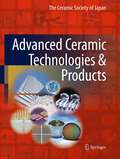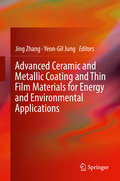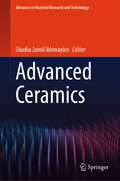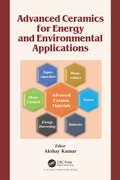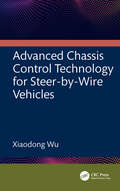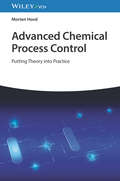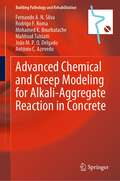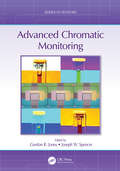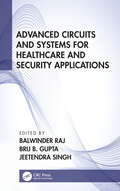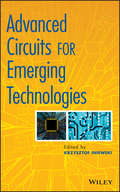- Table View
- List View
Advanced Boolean Techniques: Selected Papers from the 13th International Workshop on Boolean Problems
by Rolf Drechsler Mathias SoekenThis book describes recent findings in the domain of Boolean logic and Boolean algebra, covering application domains in circuit and system design, but also basic research in mathematics and theoretical computer science. Content includes invited chapters and a selection of the best papers presented at the 13th annual International Workshop on Boolean Problems.Provides a single-source reference to the state-of-the-art research in the field of logic synthesis and Boolean techniques;Includes a selection of the best papers presented at the 13th annual International Workshop on Boolean Problems;Covers Boolean algebras, Boolean logic, Boolean modeling, Combinatorial Search, Boolean and bitwise arithmetic, Software and tools for the solution of Boolean problems, Applications of Boolean logic and algebras, Applications to real-world problems, Boolean constraint solving, and Extensions of Boolean logic.
Advanced Boolean Techniques: Selected Papers from the 15th International Workshop on Boolean Problems
by Rolf Drechsler Sebastian HuhnThis book describes recent findings in the domain of Boolean logic and Boolean algebra, covering application domains in circuit and system design, but also basic research in mathematics and theoretical computer science. Content includes invited chapters and a selection of the best papers presented at the 15th annual International Workshop on Boolean Problems.
Advanced Brush Tyre Modelling (SpringerBriefs in Applied Sciences and Technology)
by Luigi RomanoThis book provides an in-depth understanding of tyre dynamics. In the first three chapters, new concepts are introduced in respect to the classic theory. Analytical results are derived step-by-step to guide the reader through the governing equations of the model. Transient phenomena are explained in a relatively simple way according to the brush theory. The analysis is extended to cover the case of large camber angles, which is often disregarded. The principal mechanisms behind the transient generation of tyre forces and moment are discussed in general terms, and exact solutions to the rolling contact problem are given for simple contact geometries. The last part of the book is dedicated to the approximated theories of transient generation of tyre forces and moment. Two different models, suitable for use in vehicle dynamics applications, are presented and compared.
Advanced Building Simulation
by Ali M. Malkawi Godfried AugenbroeThis book introduces recent advances in building simulation and outlines its historic development. Two important topics are described: uncertainty in simulation and coupled simulations, which are both closely linked to attempts to improve control and accuracy. This is followed by coverage of wind simulations and predictions, and then by an introduction to current systems and phenomenological modelling. Written by leading experts in the field both in the US and Europe, Advanced Building Simulation is an excellent graduate-level student textbook as well as a practical guide for architects, engineers and other construction professionals.
Advanced Business Analytics
by Fausto Pedro García Márquez Benjamin LevThe book describes advanced business analytics and shows how to apply them to many different professional areas of engineering and management. Each chapter of the book is contributed by a different author and covers a different area of business analytics. The book connects the analytic principles with business practice and provides an interface between the main disciplines of engineering/technology and the organizational, administrative and planning abilities of management. It also refers to other disciplines such as economy, finance, marketing, behavioral economics and risk analysis. This book is of special interest to engineers, economists and researchers who are developing new advances in engineering management but also to practitioners working on this subject.
Advanced CAD Modeling: Explicit, Parametric, Free-form Cad And Re-engineering (Springer Tracts in Mechanical Engineering)
by Jože Duhovnik Nikola VukašinovićThe book discusses the theoretical fundamentals of CAD graphics to enhance readers’ understanding of surface modeling and free-form design by demonstrating how to use mathematical equations to define curves and surfaces in CAD modelers. Additionally, it explains and describes the main approaches to creating CAD models out of 3D scans of physical objects. All CAD approaches are demonstrated with guided examples and supported with comprehensive engineering explanations. Furthermore, each approach includes exercises for independent consolidation of advanced CAD skills. This book is intended for engineers and designers who are already familiar with the basics of modern CAD tools, e.g. feature based and solid based modeling in 3D space, and would like to improve and expand their knowledge and experience. It is also an easy-to use guide and excellent teaching and research aid for academics and practitioners alike.
Advanced CMOS Biochips: Design and Fabrication (Analog Circuits and Signal Processing)
by Ebrahim Ghafar-Zadeh Saghi Forouhi Tayebeh AzadmousaviBiochips incorporate a verity of means including electronic, photonic and microfluidic devices; biological materials (living cells, tissue, enzymes, nucleic acid and etc.) and chemical analysis to produce the detectable signals for identification of biological phenomena. Among several competing biochip technologies, Complementary Metal Oxide Semiconductor (CMOS) process offers the advantages of low cost, integrated, high precision and portable techniques suitable for point-of-care diagnostics. Advanced CMOS Biochip takes multi-path approach: microelectronic design and implementation of bio-interfaces offering a vital contemporary view of a wide range of integrated circuits and system for electrical, magnetic, optical and mechanical sensing and actuating blocks and much more; classical knowledge of biology, biochemistry as well as microfluidics. The coverage is both practical and in depth integrating experimental, theoretical and simulation examples. By using Advanced CMOS Biochip, readers will have the fundamentals and design techniques to grasp the situation which arise typically in CMOS biochip devices.
Advanced CO2 Capture Technologies: Absorption, Adsorption, and Membrane Separation Methods (SpringerBriefs in Energy)
by Shin-ichi Nakao Katsunori Yogo Kazuya Goto Teruhiko Kai Hidetaka YamadaThis book summarises the advanced CO2 capture technologies that can be used to reduce greenhouse gas emissions, especially those from large-scale sources, such as power-generation and steel-making plants. Focusing on the fundamental chemistry and chemical processes, as well as advanced technologies, including absorption and adsorption, it also discusses other aspects of the major CO2 capture methods: membrane separation; the basic chemistry and process for CO2 capture; the development of materials and processes; and practical applications, based on the authors’ R&D experience. This book serves as a valuable reference resource for researchers, teachers and students interested in CO2 problems, providing essential information on how to capture CO2 from various types of gases efficiently. It is also of interest to practitioners and academics, as it discusses the performance of the latest technologies applied in large-scale emission sources.
Advanced Catalytic Materials
by Ashutosh Tiwari Salam TitinchiThe subject of advanced materials in catalysisbrings together recent advancements in materials synthesis and technologies to the design of novel and smart catalysts used in the field of catalysis. Nanomaterials in general show an important role in chemical processing as adsorbents, catalysts, catalyst supports and membranes, and form the basis of cutting-edge technology because of their unique structural and surface properties. Advanced Catalytic Materials is written by a distinguished group of contributors and the chapters provide comprehensive coverage of the current literature, up-to-date overviews of all aspects of advanced materials in catalysis, and present the skills needed for designing and synthesizing advanced materials. The book also showcases many topics concerning the fast-developing area of materials for catalysis and their emerging applications. The book is divided into three parts: Nanocatalysts - Architecture and Design; Organic and Inorganic Catalytic Transformations; and Functional Catalysis: Fundamentals and Applications. Specifically, the chapters discuss the following subjects: * Environmental applications of multifunctional nanocomposite catalytic materials * Transformation of nanostructured functional precursors using soft chemistry * Graphenes in heterogeneous catalysis * Gold nanoparticles-graphene composites material for catalytic application * Hydrogen generation from chemical hydrides * Ring-opening polymerization of poly(lactic acid) * Catalytic performance of metal alkoxides * Cycloaddition of CO2 and epoxides over reusable solid catalysts * Biomass derived fine chemicals using catalytic metal bio-composites * Homoleptic metal carbonyls in organic transformation * Zeolites: smart materials for novel, efficient, and versatile catalysis * Optimizing zeolitic catalysis for environmental remediation
Advanced Catalytic Materials: Current Status and Future Progress
by José Manuel Domínguez-Esquivel Manuel RamosThis book presents advances in computational methods, experimental synthesis, and advanced characterizations for novel catalytic materials. The authors show how catalytical materials can be used for various engineering oil & gas applications – mainly in low contaminants fuel production. All contributors, describe in detail novel experimental and theoretical techniques techniques and concepts for synthesis, evaluation and scaling catalytic materials and research advances in evaluation, extensive characterization and theoretical modeling using computer assisted methods and algorithms.Describes computational methods, experimental synthesis and advanced characterization for novel catalytic materials;Examines catalytic materials and corresponding engineering applications with a focus on low contaminant fuel production and derivatives;Covers the application of computer assisted quantum mechanical for fundamental understanding of electronic structure of molecular dimension catalytic materials.
Advanced Ceramic Coatings and Materials for Extreme Environments III: Ceramic Engineering and Science Proceedings, Volume 34 Issue 3
by Soshu Kirihara Sujanto Widjaja Hua-Tay Lin Taejin HwangCeramic Engineering and Science Proceedings Volume 34, Issue 3 - Advanced Ceramic Coatings and Materials for Extreme Environments III A collection of 12 papers from The American Ceramic Society's 37th International Conference on Advanced Ceramics and Composites, held in Daytona Beach, Florida, January 27-February 1, 2013. This issue includes papers presented in the Advanced Ceramic Coatings and Systems and Next Generation Technologies for Innovative Surface Coatingssymposia.
Advanced Ceramic Materials
by Ashutosh Tiwari Magdalena Szutkowska Rosario A. GerhardtCeramic materials are inorganic and non-metallic porcelains, tiles, enamels, cements, glasses and refractory bricks. Today, "ceramics" has gained a wider meaning as a new generation of materials influence on our lives; electronics, computers, communications, aerospace and other industries rely on a number of their uses. In general, advanced ceramic materials include electro-ceramics, optoelectronic-ceramics, superconductive ceramics and the more recent development of piezoelectric and dielectric ceramics. They can be considered for their features including mechanical properties, decorative textures, environmental uses, energy applications, as well as their usage in bio-ceramics, composites, functionally graded materials, intelligent ceramics and so on. Advanced Ceramic Materials brings together a group of subject matter experts who describe innovative methodologies and strategies adopted in the research and development of the advanced ceramic materials. The book is written for readers from diverse backgrounds across chemistry, physics, materials science and engineering, medical science, pharmacy, environmental technology, biotechnology, and biomedical engineering. It offers a comprehensive view of cutting-edge research on ceramic materials and technologies. Divided into 3 parts concerning design, composites and functionality, the topics discussed include: Chemical strategies of epitaxial oxide ceramics nanomaterials Biphasic, triphasic and multiphasic calcium orthophosphates Microwave assisted processing of advanced ceramic composites Continuous fiber reinforced ceramic matrix composites Yytria and magnesia doped alumina ceramic Oxidation induced crack healing SWCNTs vs MWCNTs reinforcement agents Organic and inorganic wastes in clay brick production Functional tantalum oxides Application of silver tin research on hydroxyapatite
Advanced Ceramic Matrix Composites: esign Approaches,Testing and L
by Edward R. GenerazioAdvanced ceramic composites are the focus of intense research and development today because these materials offer a unique mix of properties that make them useful and economical for major engineering applications. As part of this R&D effort, new tools for characterization, evaluation and testing have been developed and are in current use.This book brings together leading materials researchers to report on these developments. In-depth reports cover evaluation and test methods as they relate to the design of specific advanced ceramic composite materials and their applications. The reports are supplemented with extensive test result data and illustrated with numerous micrographs and schematics.
Advanced Ceramic Membranes and Applications
by Chandan Das Sujoy BoseThis book provides a balanced blend of fundamental concepts of fabrication, characterization of conventional ceramics, extending to present the recent advances in ceramic membranes. It covers the basic concepts of ceramic membranes as well as practical and theoretical knowledge in conventional and advanced ceramic membranes combined with unorthodox ideas for novel approaches in ceramic membranes. Book includes lot of real time examples derived largely from research work by authors. Aimed at researchers, students and academics in the field of membrane engineering around the globe, it has following key features: Guides readers through manufacturing, characterizing and using low-cost ceramic technology. Provides an overview of the different types of ceramic membranes, catalytic reactors and their uses. Covers industrial application, separation and purification. Includes recent developments and advances in membrane fabrication. Discusses new raw materials for ceramic membranes.
Advanced Ceramic Technologies & Products
by The Ceramic Society of JapanSince the last century, ceramics have become essential to modern society and our daily lives. They have become an indispensable product to many industries, especially within the fields of electronics, automobiles, medicine, and leisure. Japanese ceramic technologies and products are highly sophisticated and world renown, and ceramic products have long contributed to Japanese society. The true significance of ceramics to modern society however, is not well understood. This book describes in detail the background to and objective of the development, materials, manufacturing processes, functions and future prospects of a number of ceramic products. Not merely about the science and technology of ceramic manufacturing, the book is about the products themselves, as it tries to clarify how ceramics continue to contribute to our lives. It is the first such work to show advanced ceramic products in detail, from the technologies used to their application, and can be seen as a kind of illustrated reference book for modern advanced ceramic products as it is filled with easy-to-understand illustrations and photos. By including past and current product technologies, the editors hope the book will serve to guide engineers and the manufacturing sector toward a bright future of innovations for the benefit of us all.
Advanced Ceramic and Metallic Coating and Thin Film Materials for Energy and Environmental Applications
by Jing Zhang Yeon-Gil JungThis book explores the recent developments, perspectives on future research, and pertinent data from academia, industry, and government research laboratory to discuss fundamental mechanisms as well as processing and applications of advanced metallic and ceramic thin film and coating materials for energy and environmental applications. It is a platform to disseminate the latest research progress related to processing, characterization, and modelling. The authors address both thermal barrier and environmental coatings; magnetic and thermoelectric materials; and solar cell and solid oxide fuel cell materials. It is appropriate supplementary reading for students and primary reading for researchers in materials science and engineering.
Advanced Ceramics (Advances in Material Research and Technology)
by Shadia Jamil IkhmayiesThis book presents the fundamentals of advanced ceramics, their stages of development, types and classifications, advanced processing techniques, properties, sintering, and new forms of applications. It highlights specific examples such as alumina, zirconia, Mg-Al-spinels, silicon carbide, silicon nitride, ceramic composites, and thin films with their specific applications. The book reviews progress in perovskite ceramics, in which the synthesis, processing, characterization, and advanced applications of perovskite ceramics are all thoroughly discussed. In addition, developments of perovskite solar cells, the main factors affecting their stability, current problems, development prospects in the research, and application of perovskite solar cells are all highlighted. This book also includes a review of a particular class of rare-earth-based mixed-metal oxides, namely Ln2B2O7 nanostructures (B = Zr, Sn, and Ce), where advantages and disadvantages of each production technique are addressed along with the properties of as-produced nanostructures. The solar photocatalytic uses of Ln2B2O7 nanostructures such as photodegradation of contaminants are also discussed. Yttria-based transparent ceramics for photonic applications are reviewed, along with a discussion of powder synthesis, green body preparation, sintering, and optical properties. In addition, the fundamentals of electrophoretic deposition of hydroxyapatite incorporated composite coatings on metallic substrates are presented and discussed. The different types of ceramics-based self-healing coatings and their fabrication processes have also been reported and discussed in this book. These include titania, zirconia, titanium-alumina, and zirconia-alumina incorporated with Benzotriazole (BTA) as an inhibitor. Advanced ceramic materials that have been used for the purpose of wastewater treatment including ceramic sorbents, resins, aerosols, and ceramic membranes that have been widely used for wastewater treatment purposes are also discussed in depth.Moreover, the book presents the preparation of geopolymers by microwave treatments and explains how their properties can be tuned using microwaves. Furthermore, the future and perspective of these advanced ceramic materials and their modifications to ensure better efficacy toward environmental remediation purposes are highlighted in this book.
Advanced Ceramics for Energy and Environmental Applications
by Akshay KumarAdvanced Ceramics possess various unique properties and are able to withstand harsh environments. The aim of this book is to cover various aspects of the advanced ceramics like carbides, nitrides and oxides for energy and environment related applications. Advanced ceramics with additional functionality propose significant potential for greater impact in the field of energy and environmental technologies. This book focuses on the nanostructured ceramics synthesis, properties, structure-property relation and application in the area of energy and environment. It covers the high impact work from around 50 leading researchers throughout the world working in this field. This will help metallurgists, biologists, mechanical engineers, ceramicists, material scientists and researchers working in the nanotechnology field with inclusion of every aspect of advanced ceramics for energy and environmental applications.
Advanced Chassis Control Technology for Steer-by-Wire Vehicles
by Xiaodong WuAdvanced Chassis Control Technology for Steer-by-Wire Vehicles details state-of-the-art drive-by-wire technology, enabling engineers to create safer and smarter steering technology. With applications in Formula 1 driving, this book is an accessible yet ambitious introduction to the technology that is fast becoming the future of road vehicles.Steer-by-wire systems replace conventional mechanical technology with electronic sensors, controllers, and actuators, enhancing functionality when steering. Features such as variable steer ratio, customized road feel, and advanced vehicle dynamics control all ensure that this maximizes safety when driving. The book looks first at the theory behind this technology and compares it to conventional mechanical steering. It discusses control through forward and backward dynamics and a shared steering control concept to improve vehicle handling and performance, relevant to intelligent vehicles. It also explains how to create chassis domain fusion control, four independent wheels steering system and teleoperated control. Using case studies and ISOs, the book is a practical guide to safely designing steer-by-wire systems.The book is an essential guide to all engineers working in the modern automotive industry.
Advanced Chemical Process Control: Putting Theory into Practice
by Morten HovdAdvanced Chemical Process Control Bridge the gap between theory and practice with this accessible guide Process control is an area of study which seeks to optimize industrial processes, applying different strategies and technologies as required to navigate the variety of processes and their many potential challenges. Though the body of chemical process control theory is robust, it is only in recent decades that it has been effectively integrated with industrial practice to form a flexible toolkit. The need for a guide to this integration of theory and practice has therefore never been more urgent. Advanced Chemical Process Control meets this need, making advanced chemical process control accessible and useful to chemical engineers with little grounding in the theoretical principles of the subject. It provides a basic introduction to the background and mathematics of control theory, before turning to the implementation of control principles in industrial contexts. The result is a bridge between the insights of control theory and the needs of engineers in plants, factories, research facilities, and beyond. Advanced Chemical Process Control readers will also find: Detailed overview of Control Performance Monitoring (CPM), Model Predictive Control (MPC), and more Discussion of the cost benefit analysis of improved control in particular jobs Authored by a leading international expert on chemical process control Advanced Chemical Process Control is essential for chemical and process engineers looking to develop a working knowledge of process control, as well as for students and graduates entering the chemical process control field.
Advanced Chemical and Creep Modeling for Alkali-Aggregate Reaction in Concrete (Building Pathology and Rehabilitation #28)
by António C. Azevedo João M. Delgado Mahfoud Tahlaiti Fernando A. Silva Rodrigo F. Roma Mohamed K. BourbatacheThis book presents the numerical results of the use of the chemical model to analyse the advancement of the reaction and the mechanical model to simulate creep and shrinkage phenomena in COMSOL Multiphysics®, as a way to reassess concrete structures suffering from those mechanisms. Both models were implemented separately to evaluate their responses and compare them with the theoretical results and experimental benchmarks presented in the literature. The numerical simulation results showed excellent agreement with the experimental results data, with maximum disagreement not exceeding 10%, indicating that the implementation of the developed numerical models behaved very efficiently.
Advanced Chipless RFID: MIMO-Based Imaging at 60 GHz - ML Detection
by Nemai Chandra Karmakar Mohammad Zomorrodi Chamath DivarathneIntroduces advanced high-capacity data encoding and throughput improvement techniques for fully printable multi-bit Chipless RFID tags and reader systems The book proposes new approaches to chipless RFID tag encoding and tag detection that supersede their predecessors in signal processing, tag design, and reader architectures. The text is divided into two main sections: the first section introduces the fundamentals of electromagnetic (EM) imaging at mm-wave band to enhance the content capacity of Chipless RFID systems. The EM Imaging through Synthetic Aperture Radar (SAR) technique is used for data extraction. The second section presents a few smart tag detection techniques for existing chipless RFID systems. A Multiple-Input and Multiple-Output (MIMO) based tag detection technique improves the spectral efficiency and increases data bit capacity. The book concludes with a discussion of how the MIMO approach can be combined with the image based technique to introduce a complete solution with a fast imaging approach to chipless RFID systems. The book has the following salient features: Discusses new approaches to chipless RFID tags such as EM imaging, high capacity data encoding, and robust tag detection techniques Presents techniques to enhance data content capacity of tags and reliable tag detection for the readers at unlicensed microwave and mm-wave 2.45, 24 and 60 GHz instrumentation, scientific and medical (ISM) frequency bands Includes case studies of real-world applications
Advanced Chromatic Monitoring (Series in Sensors)
by Gordon R. Jones and Joseph W. SpencerAdvanced Chromatic Monitoring provides a major source of information about the novel approach of chromaticity with examples of how chromaticity may be deployed for various monitoring applications. It shows with examples what can be achieved with chromatic methods in producing relevant information with a variety of test techniques and in facilitating the interpretation of complex data about complicated situations. It will be of interest to postgraduates and researchers in a wide breadth of physical disciplines (engineering, medicine, environmental sciences) and those involved with data acquisition and analysis. Key Features: Applicable to a wide range of disciplines (engineering, medical, environmental, etc) and those interested in science, technology, data acquisition and analysis Provides an extrapolation of new knowledge well beyond that covered in existing literature with regard to dealing with complicated forms and sets of data Addresses inspiring and innovative areas of research including environmental, power delivery and medical monitoring About the Editors: Emeritus Professor Gordon R. Jones – founder and former Director of the Centre for Intelligent Monitoring Systems (CIMS), former Head of the Department of Electrical Engineering and Electronics, and former Director of Electric Arcs Research Group at the University of Liverpool. He was awarded the IEEE Education, Science and Technology Achievement Medal (1999). Professor Joe W. Spencer – the present Director of CIMS at the University of Liverpool, having been Head of the Department of Electrical Engineering and Electronics at Liverpool. He is involved in operating a multi-million pound technology transfer unit (Sensor City, Liverpool) with whose establishment he played a major role and with which CIMS has major interactions.
Advanced Circuits and Systems for Healthcare and Security Applications
by Brij B. Gupta Balwinder Raj Jeetendra SinghVLSI devices downscaling is a very significant part of the design to improve the performance of VLSI industry outcomes, which results in high speed and low power of operation of integrated devices. The increasing use of VLSI circuits dealing with highly sensitive information, such as healthcare information, means adequate security measures are required to be taken for the secure storage and transmission. Advanced Circuits and Systems for Healthcare and Security Applications provides broader coverage of the basic aspects of advanced circuits and security and introduces the corresponding principles. By the end of this book, you will be familiarized with the theoretical frameworks, technical methodologies, and empirical research findings in the field to protect your computers and information from adversaries. Advanced circuits and the comprehensive material of this book will keep you interested and involved throughout. The book is an integrated source which aims at understanding the basic concepts associated with the security of the advanced circuits and the cyber world as a first step towards achieving high-end protection from adversaries and hackers. The content includes theoretical frameworks and recent empirical findings in the field to understand the associated principles, key challenges and recent real-time applications of the advanced circuits and cybersecurity. It illustrates the notions, models, and terminologies that are widely used in the area of circuits and security, identifies the existing security issues in the field, and evaluates the underlying factors that influence the security of the systems. It emphasizes the idea of understanding the motivation of the attackers to establish adequate security measures and to mitigate security attacks in a better way. This book also outlines the exciting areas of future research where the already-existing methodologies can be implemented. Moreover, this book is suitable for students, researchers, and professionals in the who are looking forward to carry out research in the field of advanced circuits and systems for healthcare and security applications; faculty members across universities; and software developers.
Advanced Circuits for Emerging Technologies
by Krzysztof IniewskiThe book will address the-state-of-the-art in integrated circuit design in the context of emerging systems. New exciting opportunities in body area networks, wireless communications, data networking, and optical imaging are discussed. Emerging materials that can take system performance beyond standard CMOS, like Silicon on Insulator (SOI), Silicon Germanium (SiGe), and Indium Phosphide (InP) are explored. Three-dimensional (3-D) CMOS integration and co-integration with sensor technology are described as well. The book is a must for anyone serious about circuit design for future technologies. The book is written by top notch international experts in industry and academia. The intended audience is practicing engineers with integrated circuit background. The book will be also used as a recommended reading and supplementary material in graduate course curriculum. Intended audience is professionals working in the integrated circuit design field. Their job titles might be : design engineer, product manager, marketing manager, design team leader, etc. The book will be also used by graduate students. Many of the chapter authors are University Professors.
